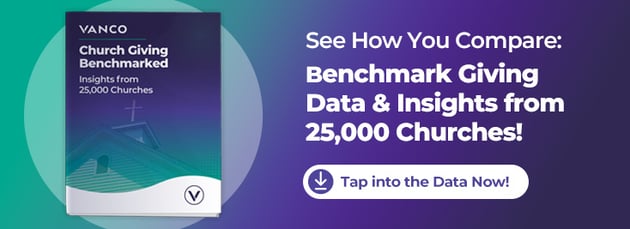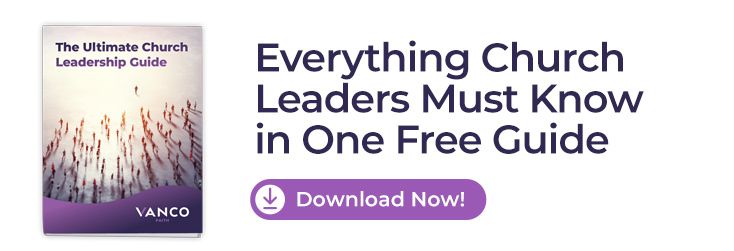 As a church, the donations you receive are essential to advancing your mission. However, with attendance declining and 37% of regular attendees not giving money to churches, there may be significant concern about maintaining your ministry.
As a church, the donations you receive are essential to advancing your mission. However, with attendance declining and 37% of regular attendees not giving money to churches, there may be significant concern about maintaining your ministry.
If your donations are dwindling, it does not necessarily mean your congregants do not want to play a role in your growth. It's more of a reflection of the changing times. With safer alternatives, people are less inclined to carry cash nowadays and prefer donating online.
Therefore, the key to increasing church donations is leveraging online giving strategies for different types and examples of ministry. Interestingly, the benefits of expanding the ways to give money go beyond raising funds. Benefits can include providing a sense of inclusivity to new generations of attendees and increasing engagement levels.
There are numerous factors to consider when embracing online church donations. This is because various approaches to digitizing church donations are suitable for different church ministries. You must understand your church's demographics, worship styles and unique needs to determine the ideal approach.
Luckily, you're in the right place. In this article, you'll learn everything there is to know about leveraging online donations to advance your cause.
Table of Contents
- Importance of Engaging Youth in Church
- Understanding the Modern Donor Landscape
- Trends Impacting Church Giving
- Strategies for Adapting Online Giving
- Steps for Creating an Online Giving Strategy
- Factors to Consider When Choosing an eGiving Solution
- Frequently Asked Questions (FAQs)
Importance of Engaging Youth in Church
On average, teens and children account for 10% of church congregations. Depending on how you look at it, this may not seem like a significant proportion, especially if you consider churches rely on the other 90% of their congregations for donations. However, that logic is flawed and may adversely affect the church.
If you consider that youth members are the future of your church, your perspective and approach toward youth ministry should change. Rather than box them into the regular service schedule, it's vital to tailor church programs to their needs.
More importantly, you should let them participate in the process. You can create a youth ministry student survey to gather their feedback. This is an ingenious way of ensuring your religious community connects with young participants. In so doing, you'll enjoy several benefits:
Builds the Next Generation of Churchgoers
Due to various factors, there is an increasing perception that the church is not as significant a factor in people's lives as before. If left unchecked, such sentiments and ideology can significantly impact church attendance in the future. In turn, this idea threatens to impact donations further.
This is why youth ministry is essential. It allows you to develop a close relationship with the next generation of congregants.
Makes Meaningful Connections
Beyond the religious aspect, the church has always been a place where the worship team and community members can interact and develop strong ties. As such, it's essential to look beyond delivering sermons, as group sessions do not encourage personal connections.
With youth ministry, you can use a personalized approach that engages them and challenges them to become better Christians.
Encourages New eGiving Strategies
Often referred to as digital natives, the younger generations have grown up with technology. As such, when given the opportunity, they prefer using tech to perform tasks and make payments, including donating to the church.
Adapting eGiving strategies to suit younger members is a great way to increase their contributions. It achieves this in two key ways: increasing the number of youth contributions and making it easier for them to contribute frequently.
Get a demo of Vanco to see how you can tailor eGiving strategies to increase youth contributions.
Understanding the Modern Donor Landscape
Traditionally, giving offerings and tithes was an in-person act that was an essential aspect of public worship. It was more than just giving money; it reinforced donors’ commitments to the church community and faith. However, with a changing society, today's donors are not bound by these traditions.
Securing sustained support now involves understanding the preferences of modern congregants. Some of the critical elements that define the modern donor landscape include:
Shifting Preferences
In this era, anyone who goes against technology will likely lose. Given its ability to streamline and enhance the efficiency of processes, technology is now a crucial part of people's lives. From receiving church communications to participating in religious events, modern donors prefer online platforms.
Diverse Engagement Channels
While it's easy to dismiss today's society as individualistic at times, that's not necessarily true. The most significant factor, especially in the church setup, is a disconnect in preferred engagement channels.
While churches have largely thrived on in-person engagement, exploring other options is essential. This is especially true when considering that many people now lean toward digital engagement. Some of the impactful engagement channels you can leverage include:
- Social media
- Crowdfunding platforms
Adopting a multifaceted approach to keep the church community engaged will maximize your reach and impact.
Data-Informed Strategies
While embracing church technology can be intimidating, it brings one benefit that makes the hassle worthwhile: data analytics. Various solutions, including software for donating online, offer unparalleled insights into your donors.
You'll understand their behaviors, preferences and demographics by analyzing historical data. With this insight, you can tailor your messaging and fundraising efforts to increase the effectiveness of your outreach.
Shift in Donor Demographics
Another element influencing the contributions you receive is the evolution of donor demographics. Today, you must pay attention to the rise, influence and dynamic engagement of millennials and women.
As you bid to make meaningful connections with church members, you must understand these trends:
Women
Women have been a critical pillar in the church for centuries and pivotal to its success. However, much of their participation has been behind the scenes, with men taking center stage.
Now that women are more empowered, they play active roles in the church, assuming more prominent roles in decision-making and forms of worship, and as donors. Beyond matters of inclusivity, identifying creative women's ministry ideas is a strategic move — it'll increase their participation and contributions to the church and encourage more women to embrace leading roles.
Understandably, because women are more empowered and financially independent nowadays, they seek to make a tangible impact through contributions. They are eager to support causes that touch on issues and values that resonate with them.
With this in mind, take proactive steps to recognize and celebrate the impact of women donors. While it's a simple step, it will make them feel appreciated and strengthen your church's relationship with this influential demographic.
With women donors, it has been noted that collaborative giving is a major preference. While they make donations independently, they seem more engaged when joining forces with like-minded people. This is primarily because such an approach amplifies their impact.
To capitalize on this preference, encourage group involvement by emphasizing the collective influence of women donors. Moreover, develop avenues and mechanisms that encourage consistent, collaborative efforts.
Millennials
As the torchbearers of the digital era, millennials bring a fresh perspective to church contributions. A desire for transparency, social impact and active participation characterize their approach. As such, understanding the motivations of millennial donors is key to tapping into this dynamic demographic.
This group’s motivation for giving is deeper than fulfilling a duty. Millennials want to know that they're making a tangible difference in society. So, to bring them on board, you must demonstrate that you support causes that align with their values.
Moreover, they value authenticity in the causes they support. Therefore, you should maintain clear communications and embrace practices that resonate profoundly with this socially conscious demographic.
Impact of Geographical Location on Giving Habits
The good thing about encouraging online donations is that it eliminates geographical restrictions. People can make donations wherever they are and whenver they want.
However, locations are key in shaping giving habits. As you explore giving options for different types of ministry, you should also try to understand how you can adapt strategies to other locations. Some factors you should consider include:
Regional Giving Patterns
Optimizing online giving strategies is about offering a suitable option for each group of people. You may notice that individuals from particular regions prefer digital transactions, while alternative options may be popular in other areas.
As you discover each region’s preferences, ensure you offer them ideal ways to give.
Cultural Sensitivities
Cultural factors intertwined with geographical location impact how individuals perceive and engage with online giving platforms. To build a global or diverse online presence, you must adapt and respect such cultural sensitivities; otherwise, you may unknowingly offend or put off members of a particular region.
Time Zone Considerations
As you know, different regions are in varying time zones. This means that in your efforts to unlock global donations, you must have a multi-regional engagement strategy that's mindful of optimal times for outreach and donation appeals.
Your goal should be to align online giving campaigns with peak activities in different regions. If you can get the timing of such appeals correct, you'll significantly improve donor responsiveness.
Trends Impacting Church Giving
For many reasons, the landscape of church giving is evolving faster than ever. Rather than wait to respond to changes that may impact the donations you collect, you should proactively address them.
To do this, you'll need to monitor the trends impacting church giving, such as:
Decrease in Traditional Tithing and Church Attendance
As mentioned, the number of church attendees has been on a downward trajectory. Coupled with increasing resistance to traditional tithing methods, this translates to lower church contributions.
With this shift in full gear, evaluating giving options and exploring innovative approaches that resonate with members' changing habits is essential. With this in mind, you should also consider adapting to lifestyle changes.
The pleasures of modern-day life come at a cost. Beyond providing for their families, your congregants must also pay for medical insurance, plus energy and education bills. All these costs make life expensive, forcing people to work more hours to live comfortably.
In turn, this limits their availability and capacity to adhere to traditional tithing schedules. Considering that it's not a lack of desire, you can help them overcome this challenge by offering flexible online giving options.
You will significantly increase church tithing and donations by ensuring members can contribute at their convenience, irrespective of their locations and schedules.
Increase in Virtual Participation
By extension, busier lives limit people's ability to attend church services physically. You can leverage technology to increase accessibility and engagement. When members can attend services online, they'll also embrace your virtual giving options.
Growth in eGiving Adoption and Its Benefits
While fewer people are attending church services in person, there's a rise in those participating and contributing online. Embracing digital giving options is in the church's best interests. As you do this, you'll unlock various benefits of online giving, including:
Convenience and Accessibility
eGiving provides a convenient and accessible avenue for church members to contribute. Whether it's a one-time donation or recurring giving, the flexibility of eGiving platforms accommodates congregants' diverse needs and preferences, promoting a more consistent and reliable income for the ministry.
Unlock Donations Beyond Cash and Checks
Let's face it: gone are the days when people walk around with cash or checks. Aside from accessing bank accounts via their phones, people also use digital wallets to store money and make transactions.
So, why limit your church donations by refusing to embrace their preferred options?
Encourage Automatic Donations
There are times when church members cannot attend services, either physically or online. In most cases, this may mean not making their regular contributions, but it does not have to be so.
Digital giving solutions enable your members to set up automatic contributions. So, whether they manage to attend services or not, their contributions will be made.
Increased Engagement and Transparency
Online giving platforms enhance engagement by providing real-time updates and transparent financial reporting. Donors appreciate knowing how their contributions directly impact the ministry. This transparency fosters trust and encourages continued support, creating a more connected and informed church community.
Strategies for Adapting Online Giving
Now that you know how online donations can help you adjust to the evolving landscape of church giving, let’s look at how to go about it. In addition to finding a suitable eGiving solution, you must also tailor approaches to suit different types of ministry. Here are some ways to do that:
Implement Effective eGiving Solutions
Implementing eGiving solutions is one thing, but getting desirable results is another. In most cases, the difference lies in a few crucial factors influencing user experience. Here are some ways you can improve adoption and contributions:
Seamless Integration
From websites to apps and virtual services, you already have existing systems for various functions. While each may function independently, they must also be able to work together without issues.
This should also be the case with your eGiving platform. It should seamlessly integrate with your existing systems to facilitate contributions.
Secure Transactions
As your digital footprint increases, so does your exposure to cyber threats. Though it may seem like churches are relatively safe because hackers target large commercial institutions and government agencies, that's not the case.
Such institutions generally invest significantly in cybersecurity and have teams of experts proactively addressing risks. On the other hand, churches deal with significant amounts of cash and data but often lack the necessary mechanisms to prevent or resolve cyberattacks.
This makes you an easy target for such incidents. Considering the trust members have when sharing personal information with the church, you must implement the necessary cybersecurity measures.
Begin by choosing an eGiving solution with robust security features to protect donor financial information. Along with ensuring compliance with data security regulations, it instills confidence in congregants.
Personalized Giving Options
Modern consumers are highly selective of who they interact with and the causes they support. For them, giving to the church is not about fulfilling a religious obligation. It's about supporting initiatives that are in line with their beliefs.
So, if you only offer a few ways to donate, the contributions you receive may be significantly limited. Consider offering personalized giving options that cater to diverse financial abilities. You can achieve this by enabling them to support specific ministries or causes via one-time or recurring contributions.
By tailoring the individual giving experience to individual preferences, you'll foster a sense of ownership and connection.
Communication and Education
Even if you have the best eGiving solution in the market, it won't improve your contributions if members don't know about it. You have to take proactive steps to inform the church and educate them on how to use it.
A vital part of your education should involve highlighting the benefits and ease of use. Additionally, providing tutorials or demos during services or through digital channels can demystify the process and encourage wider adoption.
Engage Different Generations
For your online giving initiative to succeed, you'll need to address the unique needs of different generations. Consider each group's preferences, habits and comfort levels with technology and charitable contributions.
Baby Boomers and Generation X
While baby boomers and Gen X may not be as digitally native as their younger counterparts, they are increasingly becoming comfortable with online platforms. Engage these generations by offering clear instructions and support for using eGiving tools.
Ensure you encourage adoption by emphasizing the convenience and security of online donations and their direct impact on the church's mission.
Millennials and Generation Z
Given that millennials and Gen Z are more tech-savvy, you should focus on creating engaging and interactive online giving experiences. You can achieve this through social media campaigns, real-time updates and gamification.
With this category, allowing them to interact with like-minded individuals is essential. If you couple this with a compelling social impact, you'll be sure to enhance engagement and contributions.
Encourage Intergenerational Collaboration
The varying tech comfort for different generations does not have to hinder the adoption of online giving. In fact, you can use it as a tool to foster intergenerational collaboration and unity in the church.
For instance, set up a campaign encouraging Gen Z and millennials to assist Gen X and baby boomers. This promotes a sense of community and strengthens the overall adoption of eGiving practices within the congregation.
Ultimately, online giving aims to increase members' participation in the church's growth and initiatives. As such, their comfort levels with the solutions you implement are essential. This is why you should seek regular feedback from congregants of all generations.
It's only by understanding their experiences that you can determine appropriate solutions to their concerns. Moreover, such a collaborative approach ensures that the online giving strategies remain inclusive and responsive to the evolving needs of the entire congregation.
Steps for Creating an Online Giving Strategy
In the dynamic landscape of church development, embracing online giving goes beyond investing in necessary systems. You must develop a comprehensive strategy that engages potential donors, encouraging them to contribute regularly.
Here are the steps to create a robust online giving strategy tailored to your church's unique needs:
1. Craft a Strategy Statement
The foundation of successful online giving is having clear objectives. To help with this, craft a clear and concise strategy statement that captures the critical details of your plan.
Use this template to structure your statement:
“The online contributions we make allow our parish to achieve [mission(s)] by making it easy for members to contribute so they can participate in [objective/benefits].”
This statement will serve as your guiding light, aligning the purpose of online giving with your church’s overarching goals.
2. Have Clear Objectives for Giving
Set clear and measurable objectives for your online giving efforts. Whether it's meeting the monthly operating budget, supporting specific missions, or achieving other financial goals, ensure each objective is SMART: specific, measurable, achievable, realistic and timely.
By framing your goals in this manner, you create a roadmap for success. Here are a few examples that align with having clear and measurable objectives for online giving, following the SMART criteria:
- Specific: Increase monthly donations by 20% compared to the previous quarter.
- Measurable: Raise $10,000 in donations for the summer camp scholarship fund by the end of the fundraising campaign.
- Achievable: Secure 50 new recurring monthly donors within the next 3 months.
- Realistic: Gather $50,000 in funds for a new community outreach program within 6 months.
- Timely: Collect 500 food packages for local shelters by the end of the month.
3. Create Awareness of Your Giving Platform
For your online giving platform to succeed, your congregation needs to know it exists. Ensure widespread awareness by incorporating these methods:
- Announce it during worship services.
- Mention online giving during the offering.
- Include instructions in bulletins, newsletters, emails and social media.
- Hang informational posters in your church foyer.
- Distribute and provide flyers on informational tables.
Creating awareness ensures that the convenience of online giving is accessible to all members.
4. Leverage Digital Platforms to Promote Your Online Giving Campaign
You should look beyond in-church announcements to promote online giving campaigns. Because most of your audience is digitally inclined, leverage social media platforms like Facebook, Twitter and Instagram.
Depending on your audience and initiative, determine the best platforms for reaching them. You'll enjoy better results with targeted outreach.
5. Motivate Your Audience to Give
Even if it's for a good cause, people may not automatically contribute to it. This is why you should inspire them to participate by helping them relate to the initiative. To do this successfully and consistently, you'll need to understand what motivates them to give.
For some, an obligation to God and relevance to biblical teachings are compelling enough. But with others, you must show how the cause relates to them or touches the community somehow. Furthermore, share compelling impact stories, be transparent about financial situations, and offer a secure way to give, emphasizing trust and impact.
6. Find Things Your Audience Can Support
Sometimes, your congregants may not be contributing because you're not giving them causes they want to support. Make it your mission to find worthwhile initiatives they can participate in financially.
Use simple language, have a clear call to action for each cause, and provide convenient avenues for your congregation to contribute.
Factors to Consider When Choosing an eGiving Solution
Selecting the right eGiving solution is a pivotal decision for your church's financial strategy. Opt for an eGiving platform that offers a seamless and intuitive user experience. A user-friendly interface ensures that both tech-savvy and less tech-inclined congregants can navigate it and contribute easily.
Evaluate the cost structure of the eGiving solution. Look for transparent pricing models without hidden fees. For small ministries, a cost-effective solution allows you to allocate more resources to your mission.
Consider the accessibility of the platform for your donors. Ensure it accommodates various giving preferences, including one-time donations, recurring contributions and the ability to allocate funds to specific ministries or causes.
Opt for a provider that offers responsive customer support. If issues or questions arise, reliable customer support ensures a smooth experience for the church and its donors.
Given the prevalence of mobile device usage, prioritize eGiving solutions with mobile responsiveness. A platform that adapts seamlessly to smartphones and tablets caters to the evolving digital habits of your congregation.
By considering these tips, you lay the foundation for an eGiving solution that not only meets the practical needs of your church but also enhances the overall giving experience for your congregation.
Frequently Asked Questions (FAQs)
Many factors contribute to a successful online giving initiative and overall church development. Therefore, it's understandable if you still have questions.
Here are some FAQs and their answers to help give you some clarity:
How Important Is Parental Involvement in Children's Ministry?
Children will be the custodians of the church tomorrow. Therefore, it's essential to deliver a holistic spiritual upbringing. As such, parental involvement in children's ministry is vital in providing religious teachings.
When parents play an active role, it reinforces the importance of growing in faith and gives the child a sense of belonging in the ministry. However, the church should also assist parents in such initiatives by providing easy-to-use online platforms, supporting children's programs financially and engaging parents in decision-making regarding online giving options.
How Can Churches Engage Millennials in Giving?
Engaging millennials in giving requires a strategic approach. First, embrace eGiving solutions to capitalize on their tech reliance and ensure convenience and accessibility. You should also link donations with causes they can champion to increase engagement.
This should be accompanied by transparent communication about the impact of their contributions and leveraging digital platforms to foster a sense of community.
What Are Some Effective Online Giving Strategies for Small Ministries?
Online giving is not just a tool for large ministries. There are various ways to implement it for smaller types of ministry. If you don't have a large church, you must tailor your approach to suit your scale.
To begin with, you'll need a cost-efficient and user-friendly eGiving platform. From there, actively promote it in your congregation and highlight the benefits and ease of use. In addition, consider collaborating with different church ministries to share resources that can help further the initiative.
How Can Different Types of Ministry Benefit from Online Giving?
Online giving is a versatile tool that uniquely benefits various types of ministry. For churches, it enhances the collection of tithes and offerings, even during virtual services. With missionary organizations, it facilitates seamless giving from supporters globally.
The key lies in understanding the specific needs of each ministry type and tailoring the online giving experience accordingly to ensure maximum benefit.
What Are Some Challenges Ministries Face in Transitioning to Digital Giving Platforms?
Transitioning to digital giving platforms may pose challenges to different types of ministry, including:
- Technological barriers: Some congregants, particularly older generations, may need help adapting to digital platforms.
- Cultural resistance: Long-standing traditions and cultural norms related to physical offerings may lead to resistance against online giving.
- Financial literacy: Ensuring congregants understand the online giving process, security measures and the impact of their contributions can be a hurdle.
- Resource constraints: Small ministries may need more support implementing and maintaining sophisticated digital giving platforms.
- Data security concerns: Congregants may have concerns about the security of their financial information when engaging in online transactions.
Overcoming these challenges requires a proactive approach, including educational initiatives, clear communication and ongoing support for congregants during the transition.
From Empty Plates to Overflowing Blessings: A Church Leader's Guide to Boosting Revenue
Attention church leaders! Do you cringe when it's time to talk money? You're not alone. But what if we told you there was a guide — a treasure map, if you will — that breaks down the art of financial stewardship into bite-sized pieces? Introducing an eBook that will revolutionize your church's finances:
- Learn 8 rules so powerful they could fill the collection plate to the brim.
- Discover 11 hidden treasure troves of revenue most churches are completely blind to.
- Get a 17-step master plan to making stewardship as natural as Sunday worship.














